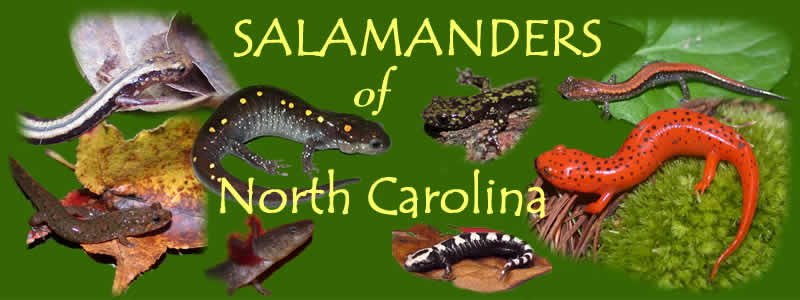|
Giant Salamanders (Family Cryptobranchidae)
Eastern Hellbender (Cryptobranchus alleganiensis)
Giant Salamanders (Family Proteidae)
Mudpuppy (Necturus maculosus)
Neuse River Waterdog (Necturus lewisi)
Dwarf Waterdog (Necturus punctatus)
Giant Salamanders (Family Amphiumidae)
Two-toed Amphiuma (Amphiuma means)
Giant Salamanders (Family Sirenidae)
Greater Siren (Siren lacertina)
Lesser Siren (Siren intermedia)
Mole Salamanders (Family Ambystomatidae)
Mole Salamander (Ambystoma talpoideum)
Marbled Salamander (Ambystoma opacum)
Mabee's Salamander (Ambystoma mabeei)
Spotted Salamander (Ambystoma maculatum)
Tiger Salamander (Ambystoma tigrinum)
Newts (Family Salamandridae)
Red-spotted Newt (Notophthalmus viridescens viridescens)
Lungless Salamanders (Family Plethodontidae)
Southern Two-lined Salamander (Eurycea cirrigera)
Blue Ridge Two-lined Salamander (Eurycea wilderae)
Long-tailed Salamander (Eurycea longicauda)
Three-lined Salamander (Eurycea guttolineata)
Dwarf and Chamberlain's Dwarf Salamander (Eurycea quadridigitata, chamberlaini)
Junaluska Salamander (Eurycea junaluska)
|
Lungless Salamanders (Family Plethodontidae) (Cont'd)
Northern and Spotted Dusky Salamanders (Desmognathus fuscus, conanti)
Southern Dusky Salamander (Desmognathus auriculatus)
Santeetlah Dusky Salamander (Desmognathus santeetlah)
Seal Salamander (Desmognathus monticola)
Black-bellied Salamander (Desmognathus quadramaculatus)
Desmognathus ochrophaeus Complex (Desmognathus carolinensis, ocoee, orestes)
Imitator Salamander (Desmognathus imitator)
Pygmy Salamander (Desmognathus wrighti)
Seepage Salamander (Desmognathus aeneus)
Shovel-nosed Salamander (Desmognathus marmoratus)
Red-backed Salamander (Plethodon cinereus)
Southern Red-backed Salamander (Plethodon serratus)
Ravine Salamander (Plethodon richmondi)
Weller's Salamander (Plethodon welleri)
Southern Zigzag Salamander (Plethodon ventralis)
Wehrle's Salamander (Plethodon wehrlei)
Grey-cheeked Salamander Complex (Plethodon amplus, meridianus, metcalfi, montanus)
Slimy Salamander Complex (Plethodon aureolus, chattahoochee, chlorobryonis, cylindraceus, glutinosus, teyahalee)
Cheoah Bald and Red-legged Salamanders (Plethodon cheoah, shermani)
Yonahlossee Salamander (Plethodon yonahlossee)
Jordan's Salamander (Plethodon jordani)
Four-toed Salamander (Hemidactylium scutatum)
Many-lined Salamander (Stereochilus marginatus)
Green Salamander (Aneides aeneus)
Spring Salamander (Gyrinophilus porphyritcus)
Mud Salamander (Pseudotriton montanus)
Red Salamander (Pseudotriton ruber)
|

